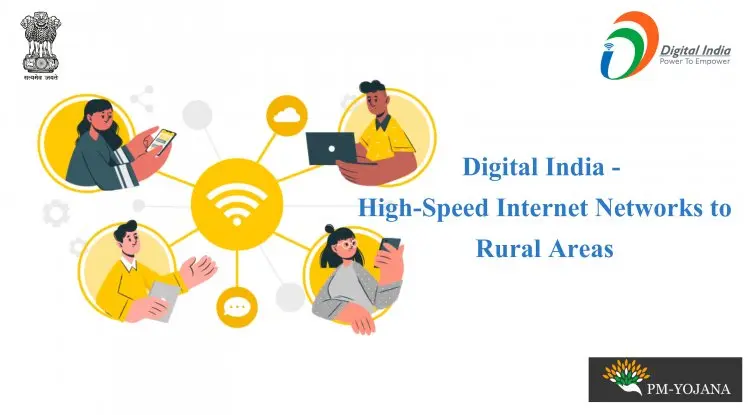Digital India - High-Speed Internet Networks to Rural Areas
Digital India Mission is an initiative that encompasses plans to connect the rural areas of the country with high-speed internet networks.

Digital India - High-Speed Internet Networks to Rural Areas
Digital India Mission is an initiative that encompasses plans to connect the rural areas of the country with high-speed internet networks.
Digital India
Digital India is a Rs 1,13,000-crore flagship programme of the Government of India with a vision to transform India into a digitally empowered society and knowledge economy
Digital India, a flagship initiative that was launched with a vision to transform India into a digitally empowered society and knowledge economy, has completed six years of its journey since its launch on 1 July, 2015.
Interacting with the beneficiaries of various Digital India initiatives across the country in June 2018, Prime Minister Narendra Modi had said that Digital India was launched to ensure that people from all walks of life, especially those from rural areas, are digitally empowered. The prime minister had said that technology has brought about ease of living and the government’s efforts are to ensure that the advantages of technology were available to all sections of society.
What is Digital India?
- Digital India is a Rs 1,13,000-crore flagship programme of the Government of India with a vision to transform India into a digitally empowered society and knowledge economy.
- Since the mid-1990s, the e-governance initiatives in India took a broader dimension with an emphasis on citizen-centric services.
- Among the major focus of e-governance was railway computerisation, land record computerisation, etc, which then slowly percolated to the states to include other facets of governance within the digital purview.
However, there were bottlenecks as the desired impact was not achieved due to limited resources. There was a clear need for more comprehensive planning and implementation and to get in place the infrastructure needed to establish a more connected government.
To know more about the Digital India Campaign, refer to the table below:
| Digital India | |
| Date of launching | 1st July 2015 |
| Government Ministry | Ministry of Electronics and Information Technology, Finance Ministry |
| Launched by | PM Narendra Modi |
| Minister of E&IT (As of December 2021) | Shri Ashwini Vaishnaw |
| Official website | https://digitalindia.gov.in/ |
Digital India is an important campaign started by the Government of India and is equally important for the IAS Exam.
What is e-Kranti?
- The National e-Governance Plan (NeGP) was initiated in 2006 with 31 Mission Mode Projects on agriculture, land records, health, education, passports, police, courts, municipalities, commercial taxes and treasuries among others.
- While 24 Mission Mode Projects have been implemented and started delivering either a full or partial range of envisaged services.
- The portfolio of Mission Mode Projects has increased from 31 to 44 and many new social sector projects like Women and Child Development, Social Benefits, Financial Inclusion, Urban Governance eBhasha among others were added as new MMPs under e-Kranti.
However, a lack of integration among government applications and databases was soon detected and the need to embrace emerging technologies like mobile and cloud was immediately felt. Thus the e-Kranti programme was revamped with a vision of “Transforming e-Governance for Transforming Governance” with the following mantras in mind:
- Transformation and not Translation
- Integrated Services and not Individual Services
- Government Process Reengineering (GPR) to be mandatory in every MMP
- ICT infrastructure on demand
- Cloud by default
- Mobile first
- Fast tracking approvals
- Mandating standards and protocols
- Language localisation
- National GIS (Geo-Spatial Information System)
- Security and Electronic Data Preservation
What are the vision areas of Digital India?
The Digital India programme is centred on three key vision areas. They are:
A. Digital Infrastructure as a Core Utility to Every Citizen
Only after the remotest of the Indian villages are digitally connected through broadband and high-speed internet, the delivery of electronic government services to every citizen, targeted social benefits, and financial inclusion can be achieved in reality. Unless there is high-speed internet and cyberspace is safe and secure even for the digitally-reluctant individual, then only the true success of Digital India can be measured. The following ingredients are key for the programme to be successful:
- Availability of high-speed internet as a core utility for delivery of services to citizens
- Cradle to grave digital identity that is unique, lifelong, online and authenticable to every citizen
- Mobile phone and bank account enabling citizen participation in digital and financial space
- Easy access to a Common Service Centre
- Shareable private space on a public cloud
- Safe and secure cyberspace
B. Governance and Services on demand
The ultimate objective was to make all government services accessible to the common man in the locality itself through common service delivery outlets. The idea was to ensure efficiency, transparency, and reliability of such services at affordable costs to realise the basic needs of the common man. Six elements were introduced to ensure governance and services are available to all citizens in the country.
- Seamlessly integrated services across departments or jurisdictions
- Availability of services in real-time from online and mobile platforms
- All citizen entitlements to be portable and available on the cloud
- Digitally transformed services for improving ease of doing business
- Making financial transactions electronic and cashless
- Leveraging Geospatial Information Systems (GIS) for decision support systems and development
C. Digital empowerment of citizens
The Digital India programme seeks to transform India into a digitally empowered society by focusing on digital literacy, digital resources, and collaborative digital platforms. For these the following points are necessary to cover:
- Universal digital literacy
- Universally accessible digital resources
- Availability of digital resources/services in Indian languages
- Collaborative digital platforms for participative governance
- Citizens not required to physically submit government documents/certificates
What are the challenges for Digital India?
With a programme of this magnitude, challenges are part of the path on every front from man to machine. Among the key challenges are:
- Ensuring last mile connectivity: Internet connectivity is a huge issue particularly in far-flung areas of the North East or in the Union Territories of Jammu and Kashmir and Ladakh. Although the issue has been addressed to a large extent, there are still many areas where a proper internet connection is still a luxury.
- Digital Illiteracy: Digital illiteracy is still high in the country which became very apparent during the ongoing COVID-19 vaccination programme. The government was forced to make offline arrangements as many people were not digitally literate enough to get themselves registered on the Cowin app for scheduling jab appointments.
- High rate of cybercrime: With people still learning to protect themselves against cyber frauds, there is another section that is looking to steal data through dishonest means.
- Inequality in digitisation: As many processes and departments remain to be completely digitised, there is a huge gap developing among departments. Moreover, the different levels of orientation among employees to embrace digital technology is also another obstacle to surmount.
What are the achievements of Digital India in the last six years?
There are many feathers in the cap of Digital India since its inception which are briefly mentioned here:
- India's rise in the UN eGovernance Index since 2014
- Creation of Aadhaar database which is the world's largest biometric-based digital identity
- BharatNet, to connect 250,00 Gram Panchayats
- National Knowledge Network is a state-of-art network and a revolutionary step towards creating a knowledge society without boundaries
- Meghraj, to utilise and harness the benefits of cloud computing
- Creating digital entrepreneurs in small towns and villages
- BPO Promotion Scheme for promotion of BPO/ITES operations across the country
- Growth in mobile phone manufacturing
- Growth in electronics manufacturing
- Launch if Electronics Development Fund in February 2016 with a corpus of $0.32 billion
- Third largest Start-up Ecosystem
- National Soil Health Card scheme was launched in February 2015
- Pradhan Mantri Gramin Digital Saksharata Abhiyan for making 60million candidates digitally literate in two years
- Swayam free online courses from school education to post-graduate education
- BHIM App incentive
- myGOV, which is the world's largest digital democracy platform







